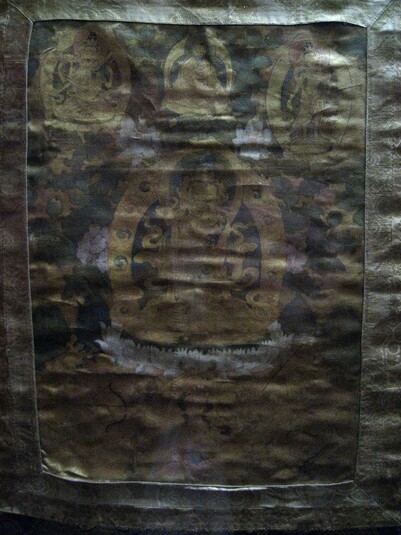
Item: Vajrasattva (Buddhist Deity) - White (with consort)
| Origin Location | Tibet |
|---|---|
| Date Range | 1700 - 1799 |
| Lineages | Nyingma, Gelug and Buddhist |
| Material | Ground Mineral Pigment, Gold Background on Cotton |
| Collection | Field Museum of Natural History |
Classification: Deity
Appearance: Peaceful
Gender: Male
Vajrasattva with Consort (Tibetan: dor je sem pa yab yum. English: Vajra Hero, Father-Mother), the buddha of purification and a meditational deity (ishtadevata). Vajrasattva is also considered the essence of all of the peaceful Buddha Families. (See the Vajrasattva Main Page and Outline Page).
Sanskrit: Vajrasattva Tibetan: Dor je sem pa
Tibetan: Dor je sem pa
This form of Vajrasattva is commonly known as the Minling Dor-sem, according to the Mindroling Tradition of Terdag Lingpa. In this form, coming from the Mindroling school of the Nyingma Tradition of Tibetan Buddhism, Vajrasattva has the role of a meditational deity and not that of a deity of purification - as is more commonly associated with Vajrasattva.
Vajrasattva is peaceful in appearance, white in colour, with one face and two hands, seated in vajra posture. The proper right hand holds an u[pright gold vajra at the level of the heart The left hand holds a vajra handled bell turned up at the left hip. Embracing Vajrasattva is the consort Vajradhatu-ishvari (Tib.: dor je ying wang chug ma), white in colour and similar to the male figure in ornaments and dress. She typically holds a curved knife and skullcup.
"To the divine illusion of the clear light of pristine awareness blazing with the glorious complete marks and examples of the spontaneous three bodies of perfect buddhahood; to Vajrasattva I bow." (Nyingma liturgical text).
At the top center is Terdag Lingpa Gyurme Dorje (1646-1714), founder of Mindroling Monastery and teacher to the 5th Dalai Lama, Ngagwang Lobzang Gyatso. On the left side is Jinasagara Avalokiteshvara from the Minling De Kun cycle of 'Revealed Treasure' (terma). On the right side is Avalokiteshvara, with one face and two hands, in a standing posture.
At the bottom center is Shri Devi, blue in colour, with one face and two arms riding a mule. On the left side is 'Activity' Trinle Pehar, white in colour, with three faces and six hands, riding a lion. On the right side is Tsi'u Marpo, red in colour, mounted atop a red horse.
All of the figures and background in the painted composition are gold in colour. This is a particular technique of painting called 'ser tang' or Gold Ground. There are also Black Ground and Red Ground Paintings. The more common, or ordinary, Tibetan paintings are known as Coloured Ground. (See Ground Colour Outline Page).
Jeff Watt 2-2011
Buddhist Deity: Vajrasattva (Mindroling Tradition)
Tradition: Mindrolling (Nyingma)
Collection of the Field Museum of Natural History (Painting)




